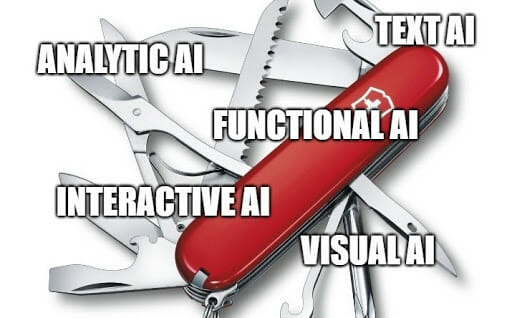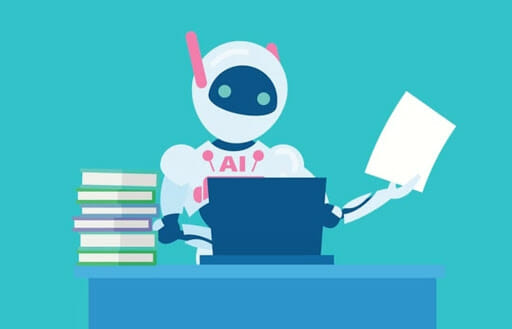The 5 Main Types of AI your Business Can Benefit from

Artificial intelligence is like a Swiss Army knife: a single tool that can be used in a myriad of different ways. We can broadly group the fields of application of AI into 5 main macro-areas:
- Text AI
- Visual AI
- Interactive AI
- Analytic AI
- Functional AI
To help you understand which knife blade you need to “sculpt” your business, let’s explore the nature of these 5 main types of artificial intelligence together!
But before moving on to the classifications, perhaps it is better to give a brief definition of AI, right?
What is AI?
Artificial intelligence (AI) is a form of intelligence demonstrated by machines. It allows computer systems to be trained on data and to produce new inputs by applying the knowledge acquired.
Anyway, this skill is based on mathematical algorithms and can be applied to the specific range of tasks that we trained our computer to perform.
A practical example
Think about chatbots, which are basically computer programs trained to interact with humans. One such chatbot could specialize in customer support for a telecommunications company.
The learning process can be carried out by providing our AI-based system with thousands of conversations relevant to the subject matter.
This way, it learns the standard conversation flow, which will likely deal with topics such as possible phone line malfunctions, bills, and so on.
Will it understand if you start talking to it about the meaning of life and your existential traumas? Probably not. So don’t do it, cause it deviates from its knowledge and skills. Call a psychologist for this.
1. Text AI
After this brief introduction, it’s time to delve into the main types of AI, starting with Text AI.
It is a form of artificial intelligence that can be leveraged extensively by businesses for example in the fields of machine translation, text recognition, and speech-to-text conversion.
While these areas are normally associated with internet giants like Amazon, small and medium-sized businesses can also benefit from similar tools, for example for their knowledge base.
Improving corporate knowledge base with Text AI
Imagine having to do a search. The traditional approach involves searching for information or documents based on specific keywords.
By implementing tools based on artificial intelligence, however, it is possible to do it much more effectively without the need for keywords (which may be missing in the document we are looking for).
Text AI allows a search based on semantic analysis and natural language processing, which doesn’t works “mechanically” on the basis of specific words but identifies the general context and therefore also recognizes any synonyms.
2. Visual AI
Thanks to Visual AI, which deals firstly with computer vision and the field of augmented reality, it’s possible for businesses to scan, identify and categorize objects or to get useful insights from pics and videos.
It is an excellent tool for a giant range of applications, from security cameras to waste sorting and management, from the maintenance of machines and facilities to car damage recognition and estimate.
Even artisans and manufacturers can benefit from it, for example by enhancing the quality check of their products with high-performing cybernetic eyes!
3. Interactive AI
Did I mention chatbots already? Well, together with intelligent assistants, they are the typical result of this type of artificial intelligence.
Interactive AI is at the heart of business automation when it comes to improving communication speed (making it available 24 hours a day) without losing points on the quality of interactions.
It gives computers the ability to answer predefined questions and even understand the context of a conversation, especially when paired with machine learning and deep learning technologies.
AI to streamline internal business processes
Another possible application of interactive AI and chatbots is the improvement of a company’s internal processes, for example by streamlining and speeding up communication between employees and HR.
Wanna ask about vacation days? Talk to the chatbot. He will answer “no” anyway.

4. Analytic AI
Analytic AI is a type that is strictly related to and influenced by machine learning and deep learning tech.
In fact, its main focus is on scanning immense datasets to recognize recurring patterns and relations and use the information collected to give insights or even to forecast possible future developments.
This is a crucial factor for the decision-making processes of any company, which should always be primarily based on data, of course.
AI and sentimental analysis
We can apply analytic AI in sentimental analysis, which is quite common in the field of HR to understand the potential of job candidates based on their previous career and personal information.
It is also a game-breaking element of good customer care and retention strategy, thanks to the possibility of getting precious insights on your customers’ needs and preferences… or his/her likelihood of getting angry.
5. Functional AI
Functional AI shares analytic AI’s passion for rummaging among massive datasets and searching for interesting relations and patterns.
The main difference between these two types concerns their “attitude”. While analytic AI deals with recommendations, functional AI likes action!
For example, if one sensor detects a fault in some machine of your factory, the AI-based system will recognize the problem by comparing its actual working pattern with the standard one.
Then, functional AI will not simply send a warning but also trigger the shutdown command. Yep, this AI has a great spirit of initiative.
AI can help virtually any business
Are you running a business and still believe you don’t need AI cause “hey, it’s stuff for big shots”? Well, I hope that I made you change your mind.
As we have seen, the potential of artificial intelligence is truly vast and manifests itself in an infinite number of different ways. This is a trend that looks set to continue and grow in the future, as demonstrated by numerous surveys and studies.
According to the Accenture Technology Vision 2019 report, for example, 89% of companies have already implemented or tested AI.
If you are in the remaining 11%… this is the right time to try!
Need support with your software development?

Andrea Di Stefano
Andrea is a journalist and teacher of Italian with a long-standing interest in tech and media. He loves to handle touchscreens, but to correct his students’ homework he prefers the good old red marker on paper!
